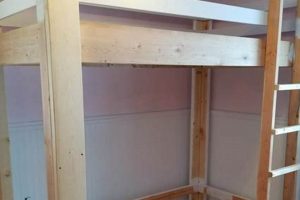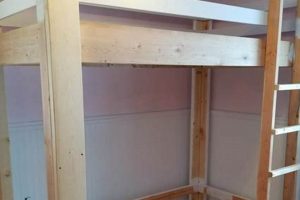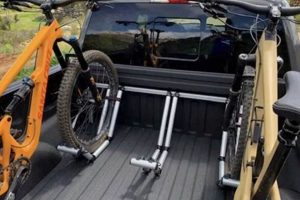Construction of storage solutions within a pickup truck’s cargo area, achieved through individual effort, allows for enhanced organization and accessibility of tools, equipment, and other items. An example includes fabricating a sliding drawer system using materials like plywood, metal framing, and drawer slides to compartmentalize and secure items within the truck bed. This approach contrasts with purchasing pre-made storage systems.
The practice offers several advantages. It provides customized solutions tailored to specific needs and truck bed dimensions, potentially reducing costs compared to commercial alternatives. Historically, vehicle owners have sought methods to maximize cargo space and protect equipment from weather and theft. These custom solutions continue this tradition by offering secure and organized storage, increasing efficiency for various activities, from work to recreation.
The subsequent discussion will detail various design considerations, material choices, and construction techniques relevant to creating a functional and durable in-vehicle storage system. Emphasis will be placed on safety, ease of use, and long-term reliability of self-made vehicle storage solutions.
Essential Considerations for Fabricating Truck Bed Storage Systems
The following recommendations address critical aspects of designing and building custom storage within a pickup truck bed. Attention to these points will contribute to a safe, functional, and durable storage solution.
Tip 1: Measure Accurately: Precise measurements of the truck bed’s interior are paramount. Account for wheel wells, bed ribs, and any other obstructions to ensure a proper fit. Create a detailed schematic before commencing construction.
Tip 2: Select Durable Materials: Choose materials resistant to moisture, UV exposure, and physical stress. Marine-grade plywood, treated lumber, and powder-coated steel offer increased longevity compared to standard materials.
Tip 3: Prioritize Secure Fastening: Employ robust fasteners and attachment methods to secure the storage system to the truck bed. Through-bolting to the bed frame, where feasible, provides superior stability compared to relying solely on the bed’s sheet metal.
Tip 4: Incorporate a Robust Locking Mechanism: Integrate a secure locking system to deter theft and prevent drawers from opening during transit. Consider keyed locks, latches with padlock hasps, or electronically controlled locking mechanisms.
Tip 5: Account for Load Distribution: Distribute the weight of the storage system and its contents evenly across the truck bed. Reinforce areas prone to high stress to prevent structural failure.
Tip 6: Plan for Accessibility: Design the drawer system to allow easy access to stored items. Full-extension drawer slides facilitate complete access to the contents of each drawer.
Tip 7: Consider Weather Protection: Implement features to protect stored items from the elements. Weather stripping around drawer openings and a sealed lid will minimize water and dust intrusion.
Adherence to these guidelines will result in a reliable and secure truck bed storage system, optimizing the utility of the vehicle while protecting its contents.
The subsequent section will explore specific design variations and advanced features that can be incorporated into a custom truck bed storage system.
1. Dimensions
The dimensional accuracy of a self-constructed storage system within a truck bed directly influences its functionality and structural integrity. Incorrect measurements can lead to a poorly fitting system, reducing available storage space and potentially causing damage to the truck bed itself. For instance, a drawer system built wider than the space between the wheel wells would be unusable. Precise measurements, accounting for the bed’s contours, are, therefore, critical in maximizing usable volume and ensuring a secure, stable fit. The effect of neglecting accurate dimensions is a system that is either unusable or requires significant modification, wasting time and resources.
Beyond the overall footprint, internal dimensions also dictate the usability of individual drawers. Consider the need to store specific items, such as tools or equipment. Insufficient drawer height or width would render the system ineffective for its intended purpose. A practical example is constructing drawers to accommodate standard-sized toolboxes or frequently used power tools. Accurate internal measurements ensure efficient organization and easy retrieval of stored items. Moreover, drawer depth must be considered in relation to the ease of accessing items furthest from the drawer opening; excessive depth can hinder accessibility.
In summary, dimensional accuracy represents a foundational aspect of the overall design and execution. Challenges in obtaining precise measurements can be mitigated through careful planning, the use of appropriate measuring tools, and the creation of detailed schematics. The relationship between dimensional accuracy and the overall success of the project is undeniable; precise measurements are a prerequisite for a functional, durable, and aesthetically pleasing truck bed storage system.
2. Materials
The selection of materials constitutes a critical determinant in the long-term performance and utility of self-constructed truck bed drawer systems. The truck bed environment presents a demanding operational context, characterized by exposure to moisture, ultraviolet radiation, temperature fluctuations, and mechanical stresses from cargo and vehicle movement. Therefore, the materials employed must possess inherent resistance to these factors to ensure system longevity and prevent premature failure. For instance, using untreated plywood in a truck bed drawer system would likely result in warping, rotting, and structural weakness within a relatively short period due to moisture exposure. Conversely, marine-grade plywood, treated lumber, or powder-coated steel provide enhanced resistance to environmental degradation, extending the service life of the storage solution.
Beyond environmental resistance, material selection also impacts the system’s load-bearing capacity and overall strength. The storage system must be capable of supporting the weight of its contents without deformation or collapse. For example, lightweight materials such as thin-gauge aluminum may be suitable for drawers intended to store lightweight items, but they would prove inadequate for heavier tools or equipment. In such cases, stronger materials, such as steel or thick plywood, are necessary to ensure structural integrity. The choice of drawer slides also plays a role; heavy-duty slides with high load ratings are essential for drawers that will bear significant weight. Furthermore, the fastening methods employed must be compatible with the chosen materials; appropriate screws, bolts, or adhesives should be selected to provide secure connections.
In conclusion, the relationship between material selection and the success of a truck bed drawer project is inextricably linked. Careful consideration must be given to the environmental conditions, load requirements, and intended use of the system when choosing materials. Neglecting these factors can lead to a storage solution that is prone to failure, requires frequent maintenance, or fails to meet the user’s needs. Therefore, investing in durable, high-quality materials is a prudent decision that will ultimately enhance the value and longevity of the self-constructed truck bed drawer system. The material quality affects cost of construction. A compromise of material for low-cost must be balance and should not sacrifice security.
3. Fastening
Fastening, in the context of self-constructed truck bed drawer systems, represents the critical element that ensures structural integrity and operational safety. The efficacy of the fastening methods directly dictates the system’s ability to withstand the dynamic forces encountered during vehicle operation and the static loads imposed by stored contents. The selection and implementation of appropriate fastening techniques are paramount to preventing component separation, system instability, and potential damage to the vehicle or its cargo.
- Type of Fastener
The type of fastener employed significantly impacts the strength and durability of the system. Options include screws, bolts, rivets, and adhesives, each possessing distinct advantages and disadvantages. Screws offer ease of installation and disassembly, suitable for lighter-duty applications. Bolts, particularly those with locking mechanisms, provide greater clamping force and resistance to vibration, ideal for securing major structural components. Rivets offer a permanent connection, while adhesives can distribute stress over a wider area, suitable for bonding dissimilar materials. Selecting the appropriate fastener requires careful consideration of the materials being joined, the anticipated loads, and the desired level of permanence.
- Placement and Density
The strategic placement and density of fasteners contribute directly to the system’s overall stability. Concentrating fasteners in areas of high stress, such as joints and corners, reinforces these critical points. Adequate fastener density, or the number of fasteners per unit area, ensures uniform load distribution and prevents localized stress concentrations. Insufficient fastener density can lead to component separation under load, compromising the system’s integrity. Proper planning of fastener placement and density is essential for maximizing structural performance.
- Material Compatibility
Compatibility between the fastener material and the materials being joined is crucial for preventing corrosion and ensuring long-term durability. Dissimilar metals can react electrochemically, leading to galvanic corrosion that weakens the fasteners and surrounding materials. For example, using steel fasteners with aluminum components in a moist environment can accelerate corrosion. Selecting fasteners made from materials compatible with the surrounding components, such as stainless steel for marine applications, minimizes the risk of corrosion and extends the system’s lifespan.
- Installation Technique
Proper installation techniques are essential for maximizing the effectiveness of the chosen fasteners. Over-tightening screws or bolts can strip threads or damage the surrounding materials, while under-tightening can result in insufficient clamping force. Using appropriate tools and following recommended torque specifications are crucial for achieving optimal fastener performance. Furthermore, pre-drilling pilot holes can prevent splitting or cracking of wood or plastic components during screw installation, ensuring a secure and lasting connection.
These facets underscore the importance of a comprehensive approach to fastening in self-constructed truck bed drawer systems. The selection of appropriate fasteners, strategic placement and density, material compatibility, and proper installation techniques are all critical factors that influence the system’s structural integrity, operational safety, and long-term durability. Neglecting any of these aspects can compromise the system’s performance and potentially lead to costly repairs or even system failure. Understanding and addressing these considerations is essential for ensuring a successful and reliable truck bed drawer project.
4. Security
The incorporation of security measures is paramount in the construction of truck bed drawer systems. These systems, by their nature, store valuable tools, equipment, or personal belongings within the relatively unsecured environment of a pickup truck bed. Consequently, the design and implementation of effective security features are critical to deterring theft and protecting the system’s contents.
- Locking Mechanisms
The choice of locking mechanisms directly influences the level of security provided. Simple latches may deter casual theft, but more robust locking systems, such as keyed deadbolts or combination locks, offer greater resistance to forced entry. Electronic locking systems, integrated with the vehicle’s security system, represent an advanced option, providing remote access control and alarm integration. The selection of a locking mechanism should align with the value of the items stored within the drawer system and the perceived risk of theft.
- Material Reinforcement
Reinforcing the drawer system’s structural components with hardened materials enhances its resistance to forced entry. Steel plates, integrated into the drawer faces or surrounding frame, can significantly increase the time and effort required to breach the system. The use of tamper-resistant fasteners further complicates attempts to disassemble or compromise the drawer system’s security. Material reinforcement serves as a passive security measure, deterring potential thieves and increasing the likelihood of detection.
- Concealment and Integration
Disguising the presence of a drawer system or seamlessly integrating it with the truck bed’s design can reduce its visibility and deter potential theft. A flush-mounted system, concealed beneath a tonneau cover or camper shell, minimizes its exposure to prying eyes. The integration of security features, such as hidden locking mechanisms or disguised access points, further complicates unauthorized access. Concealment and integration contribute to a low-profile security strategy, reducing the likelihood of the drawer system becoming a target.
- Alarm Systems and Tracking Devices
The integration of alarm systems or GPS tracking devices provides an active layer of security, alerting the owner to unauthorized access or enabling the recovery of stolen items. Motion sensors, integrated within the drawer system, can trigger an audible alarm or send a notification to the owner’s mobile device. GPS tracking devices, concealed within the system, allow for the real-time monitoring of its location, facilitating recovery in the event of theft. These advanced security measures provide an added layer of protection, deterring theft and increasing the chances of recovering stolen property.
The effective integration of security features within a self-constructed truck bed drawer system requires a comprehensive approach, encompassing both passive and active security measures. The selection of appropriate locking mechanisms, material reinforcement, concealment strategies, and electronic security devices should be tailored to the specific needs and circumstances of the user. The ultimate goal is to create a secure and reliable storage solution that effectively deters theft and protects valuable belongings.
5. Accessibility
Accessibility, in the context of self-constructed truck bed drawer systems, refers to the ease with which users can retrieve and store items within the system. This consideration directly impacts the efficiency and practicality of the storage solution. A system that is difficult to access negates many of the advantages associated with organized storage.
- Drawer Extension
The extent to which drawers can be extended from the truck bed significantly influences accessibility. Full-extension drawer slides allow complete access to the contents of the entire drawer, while partial-extension slides limit access to the front portion. Selecting full-extension slides is crucial for maximizing accessibility, particularly for deep drawers or when storing small items. For example, accessing tools located at the back of a partially extended drawer can be cumbersome and inefficient.
- Drawer Height and Configuration
The height and internal configuration of drawers must be tailored to the specific items being stored. Drawers that are too shallow may not accommodate taller items, while overly deep drawers can make it difficult to locate smaller objects. Adjustable dividers and customizable drawer layouts enhance accessibility by allowing users to organize and compartmentalize their belongings. Consider a drawer system designed to store power tools, where adjustable dividers could separate individual tools and prevent them from shifting during transport.
- Lid Design and Opening Mechanisms
For systems incorporating a top lid or covering, the design and opening mechanism directly impact accessibility. A hinged lid that opens fully and remains securely in the open position allows for unimpeded access to the drawer contents. Similarly, the ease with which the lid can be opened and closed is a critical factor. Heavy lids or cumbersome latches can make accessing the drawer system a chore. Gas struts or other assistive mechanisms can be employed to ease the opening and closing process and improve overall accessibility.
- Location and Mounting Height
The location of the drawer system within the truck bed and its mounting height affect its accessibility. A system positioned too far forward in the bed may be difficult to reach from the rear. Similarly, a system mounted too high may require users to strain or climb to access its contents. Optimizing the system’s location and mounting height ensures that it is easily accessible for users of varying heights and physical abilities. A system mounted at a comfortable working height minimizes the need to bend or reach, improving overall ergonomics and usability.
These aspects of accessibility directly influence the practicality and user-friendliness of self-constructed truck bed drawer systems. Prioritizing accessibility during the design and construction process ensures that the system provides a convenient and efficient storage solution, maximizing its value and utility.
6. Weatherproofing
Weatherproofing is an indispensable element in the design and construction of self-built truck bed drawer systems. These systems are inherently exposed to environmental factors, including precipitation, humidity, dust, and ultraviolet radiation. The absence of adequate weatherproofing measures leads to detrimental effects on the system’s structural integrity and the condition of its contents. Moisture ingress can cause wood to warp, rot, and delaminate, resulting in structural failure and rendering the system unusable. Humidity promotes corrosion of metallic components, diminishing their strength and longevity. Dust accumulation contaminates stored items, potentially damaging sensitive equipment. Ultraviolet radiation degrades plastics and other synthetic materials, causing them to become brittle and prone to cracking. For example, a system constructed with untreated plywood and lacking weather seals would quickly deteriorate in a humid climate, leading to costly repairs or replacement.
Effective weatherproofing strategies involve a multi-faceted approach. The selection of water-resistant materials, such as marine-grade plywood or treated lumber, forms the foundation. The application of protective coatings, such as paint, varnish, or epoxy, provides an additional barrier against moisture and UV radiation. Sealing all seams and joints with silicone caulk or weather stripping prevents water from penetrating the system’s interior. Incorporating drainage holes allows any accumulated water to escape, preventing its build-up. A properly designed and constructed lid or cover protects the system’s contents from direct exposure to the elements. These measures not only extend the lifespan of the drawer system but also ensure the safe and secure storage of valuable tools and equipment. The cost of weatherproofing is far less than the cost of repair.
In conclusion, weatherproofing is not merely an optional feature but a critical requirement for the long-term functionality and reliability of self-built truck bed drawer systems. Neglecting weatherproofing considerations exposes the system and its contents to significant risks, resulting in premature failure and potential economic loss. A proactive approach to weatherproofing, incorporating appropriate materials, coatings, and sealing techniques, ensures the system’s resilience in harsh environmental conditions, providing years of dependable service. Failure to waterproof will result in lost of investment and put the security of tools and equipment at risk.
7. Load Capacity
The intended load capacity is a primary design constraint in self-constructed truck bed drawer systems. Failure to adequately account for this factor results in structural failure, potentially damaging the drawer system, the truck bed, and any cargo being transported. The anticipated weight of tools, equipment, and other items to be stored directly dictates the material selection, structural design, and fastening methods employed. A system designed to carry heavy equipment requires robust materials, reinforced construction techniques, and secure attachment points to the truck bed. Overestimation of the load reduces efficiency while underestimation creates a safety hazard.
Real-world examples illustrate the importance of accurate load capacity assessment. A drawer system constructed from thin plywood and secured with insufficient fasteners, when overloaded with heavy tools, may experience warping, sagging, or complete collapse. Conversely, a system fabricated from thick steel and over-engineered for its intended purpose may add unnecessary weight to the vehicle, reducing fuel efficiency and payload capacity. Therefore, a practical understanding of material properties, structural mechanics, and weight distribution is essential for constructing a safe and functional truck bed drawer system. The vehicle’s gross vehicle weight rating (GVWR) should also be considered so as not to overload the vehicle.
In summary, load capacity represents a critical parameter in the design and construction of truck bed drawer systems. The ability to accurately estimate the intended load, select appropriate materials and construction techniques, and implement secure fastening methods is essential for ensuring the system’s structural integrity, operational safety, and long-term durability. Ignoring this parameter leads to a compromised system with potential for damage or harm. An additional challenge is to balance strength with weight to minimize the impact on the vehicles overall performance.
Frequently Asked Questions
The following questions address common concerns and misconceptions regarding the design and construction of self-made storage systems for pickup truck beds. These answers aim to provide clarity and guidance for those undertaking such projects.
Question 1: What are the primary safety considerations when building truck bed drawers?
Securing the drawer system to the truck bed frame is paramount to prevent movement during transit. Furthermore, adherence to weight limits is critical to avoid compromising vehicle handling and safety. Sharp edges and protruding hardware should be avoided to minimize the risk of injury.
Question 2: What are the most common mistakes to avoid during construction?
Inaccurate measurements represent a significant source of errors. Utilizing inappropriate materials for the intended load and environment can also lead to premature failure. Insufficient attention to fastening methods and security measures are also frequent oversights.
Question 3: How does climate affect the choice of materials for truck bed drawers?
Humid climates necessitate the use of water-resistant materials such as marine-grade plywood or treated lumber to prevent rot and warping. Arid climates require consideration of UV resistance to prevent degradation of plastics and synthetic materials. Temperature fluctuations can also impact material expansion and contraction, influencing joint stability.
Question 4: Are permits required for installing truck bed drawers?
Local regulations vary. Contacting the relevant transportation authorities or building departments is advisable to determine whether permits are necessary. Modifications that alter the vehicle’s structural integrity may be subject to inspection and approval.
Question 5: How can theft be prevented when using truck bed drawers?
Robust locking mechanisms are essential for deterring unauthorized access. Reinforcing the drawer system’s structure with hardened materials enhances its resistance to forced entry. Concealing the drawer system beneath a tonneau cover or camper shell can also reduce its visibility. Integration of an alarm system is also recommended.
Question 6: What are the most important tools needed for this project?
Essential tools include a measuring tape, circular saw or table saw, drill with various bits, level, and appropriate fastening hardware. Personal protective equipment, such as safety glasses and gloves, is also essential for safe operation.
In summary, careful planning, accurate execution, and a thorough understanding of safety considerations are crucial for a successful truck bed drawer construction. Prioritizing quality and durability ensures a long-lasting and reliable storage solution.
The subsequent section will offer advanced techniques and considerations for customizing a truck bed drawer system to meet specific needs and preferences.
Truck Bed Drawers DIY
This exploration has emphasized the multifaceted considerations inherent in executing a self-constructed storage system for pickup truck beds. The dimensional accuracy, material selection, fastening techniques, security measures, accessibility features, weatherproofing methods, and load capacity calculations each exert a significant influence on the system’s ultimate utility and longevity. Adherence to established principles of design and construction is paramount for ensuring a safe and functional outcome.
The creation of a robust and secure truck bed storage solution represents a substantial undertaking. Careful planning, meticulous execution, and a commitment to quality materials are essential for maximizing the investment. The resulting system, if properly implemented, offers a significant enhancement to the vehicle’s utility and organizational capabilities, representing a tangible return on the initial effort.







